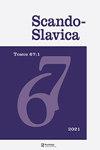Definiteness in Slavic, Baltic, and Germanic
IF 0.2
0 HUMANITIES, MULTIDISCIPLINARY
引用次数: 4
Abstract
ABSTRACT This paper offers an exploration of a European linguistic area at the dawn of history and of shifting convergence zones (Sprachbünde) in Europe since prehistoric times. Its main focus is on the development of Adjective-Phrase Definiteness marking in Germanic, Baltic, and Slavic (§1). Traditionally this commonality among the three language groups has been considered a coincidence. But in recent years several comparativists have proclaimed it a result of areal convergence. This is an attractive idea for several reasons (§2), not least because Definiteness is a category that easily spreads through language contact, as the Standard Average European development shows (§3). The paper addresses the question how Adjective-Phrase Definiteness marking might have arisen or been propagated among these three language groups, and several hypothetical contact scenarios are worked out in detail (§§4–5). An excursus highlights the conceptual apparatus applied here and some outstanding issues (§6). The conclusion evaluates the alternative hypothetical scenarios of change (§7).斯拉夫语、波罗的海语和日耳曼语中的确定性
本文提供了一个探索在历史的黎明欧洲语言区域和转移收敛区(sprachb nde)在欧洲自史前时代。它的主要焦点是在日耳曼语,波罗的海语和斯拉夫语中形容词-短语确定性标记的发展(§1)。传统上,这三种语言的共同性被认为是一种巧合。但近年来,一些比较主义者宣称这是地区趋同的结果。这是一个有吸引力的想法,原因有几个(§2),尤其是因为确定性是一个很容易通过语言接触传播的范畴,正如欧洲标准平均发展(§3)所表明的那样。本文讨论了形容词-短语确定性标记在这三个语言群体中可能产生或传播的问题,并详细制定了几个假设的接触场景(§§4-5)。附言强调了这里使用的概念工具和一些突出的问题(§6)。结论评估了变化的其他假设情景(§7)。
本文章由计算机程序翻译,如有差异,请以英文原文为准。
求助全文
约1分钟内获得全文
求助全文

 求助内容:
求助内容: 应助结果提醒方式:
应助结果提醒方式:


